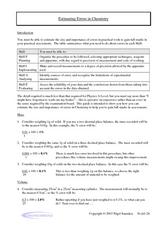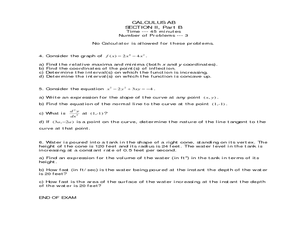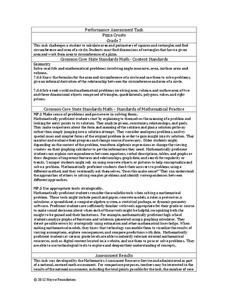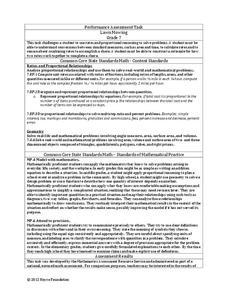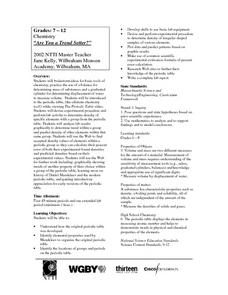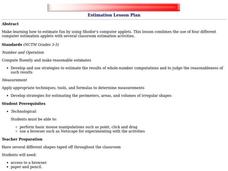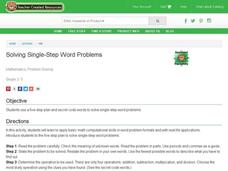Curated OER
Estimating Errors in Chemistry
Estimating Errors in Chemistry is a detailed handout that illustrates the importance of calculating the percent error when working in the chemistry lab. There are no actual problems to solve, just notes and examples of calculations. Hand...
Curated OER
Unit 0 Review - Measurement Lab Equipment
Review questions like these can be used in your biology, chemistry, physics, or earth science classes! They assess scientists' understanding of laboratory measurement tools including graduated cylinders, thermometers, and balances. They...
Kenan Fellows
Density
Most scholars associate density with floating, but how do scientists determine the exact density of an unknown liquid? The third lesson in a seven-part series challenges scholars to find the mass and volume of two unknown liquids. Each...
Curated OER
Taking Measurements at Home
In this measurements worksheet, learners find their weight, height, width and depth of their bodies at home using equipment around their homes. They use the proper number of significant figures to record their answers and they find the...
Curated OER
What Can We Measure about Chemicals?
In this measuring chemicals worksheet, students determine the accuracy and precision of measurements and distinguish between the two. They find the percent composition of compounds, the molar mass of compounds and the volume of gases at...
Curated OER
Quiz: Error in Measurement
In this measurement worksheet, students are presented with the measurements of two items. They compute the upper and lower limits of the range of tolerance for the measurements. Students find the absolute error and percent of error for...
Curated OER
Quiz: Error in Measurement
In this error in measurement quiz, students read given problems and determine the percent of error, find the absolute error, the relative error, and identify the limits. This one-page worksheet contains ten problems.
Curated OER
Calculus Exam
In In this calculus worksheet, student solve 6 multi-step problems involving volume, intervals, acceleration, and graphing. A graphing calculator will be necessary to complete the worksheet.
Curated OER
Chemistry Midterm Practice Exam
A comprehensive practice exam, this resource covers many areas of chemistry. The test includes 71 multiple choice questions on topics such as problem solving, chemical equations, chemical formulas, thermodynamics, acids and bases, and...
Curated OER
Hess' Law Data Sheet
In this Hess' Law worksheet, students write their data and calculations from the lab they performed on Hess's Law. They calculate the heat of reactions per mole of substances used and calculate the theoretical heat of reaction and...
Curated OER
What Can We Measure About Chemicals?
In this measuring chemicals worksheet, students investigate measurements of an aluminum slab including the length, width, height, mass, volume and density. They do the same for a piece of aluminum foil and they compare their...
Curated OER
Measure Mania
Groups of learners rotate through five classroom stations to estimate, measure, and record volume, length, weight, mass, and area using both customary and metric measure. They evaluate their data to determine how close their estimates...
Curriculum Corner
7th Grade Math "I Can" Statement Posters
Translate the Common Core math standards into a series of achievable "I can" statements with this collection of classroom displays. Offering posters for each standard, this resource is a great way to support your seventh graders as...
Curriculum Corner
7th Grade Math Common Core Checklist
With so many math standards to fit into a school year, it can be difficult keeping track of what you have and have not covered. This collection of Common Core checklists allows you to maintain a running record of when each...
Noyce Foundation
Parallelogram
Parallelograms are pairs of triangles all the way around. Pupils measure to determine the area and perimeter of a parallelogram. They then find the area of the tirangles formed by drawing a diagonal of the parallelogram and compare their...
Noyce Foundation
Pizza Crusts
Enough stuffed crust to go around. Pupils calculate the area and perimeter of a variety of pizza shapes, including rectangular and circular. Individuals design rectangular pizzas with a given area to maximize the amount of crust and do...
Noyce Foundation
Lawn Mowing
This is how long we mow the lawn together. The assessment requires the class to work with combining ratios and proportional reasoning. Pupils determine the unit rate of mowers and calculate the time required to mow a lawn if they work...
Curated OER
Are You a Trend Setter?
Young scholars are introduced to the periodic table of elements. They devise and perform and experiment in which they determine the density of specific elements. They use their results to predict the density of other elements in the same...
Noyce Foundation
Time to Get Clean
It's assessment time! Determine your young mathematicians' understanding of elapsed time with this brief, five-question quiz.
Curated OER
Discovering Density
Students explore the physical properties of density. In this hands-on lesson, students calculate density and distinguish between intensive and extensive properties.
Curated OER
Estimation
Students complete computer activities about estimating if items are more or less than a given amount. In this estimation lesson plan, students also estimate measurements around the classroom.
Curated OER
Data Collection Review Sheet
In this data collection worksheet, students determine the number of significant figures in the given values, describe the difference between accuracy and precision, and calculate density and mass. This worksheet has 1 short answer...
Curated OER
Solving Single-Step Word Problems
Math wizards learn the five-step plan to solve math word problems. They investigate the five-step process for solving word problems, and examine the use of code words for each of the operations and solve a problem using the strategies.
Curated OER
Finding the Area Under A Curve with Random Probability
Students explore the concept of area under a curve. In this area under a curve lesson, students find the area under a curve using the Monte Carlo method using random points and probability. Students calculate the area under the same...


